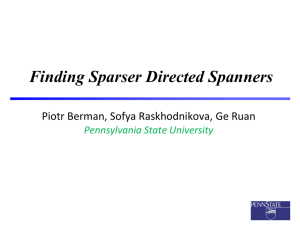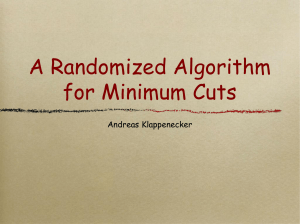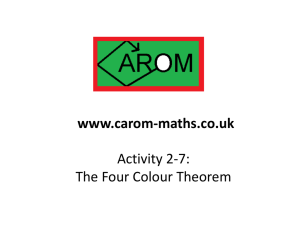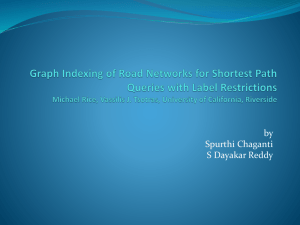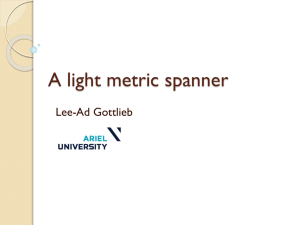Improved Approximation for the Directed Spanner Problem
advertisement
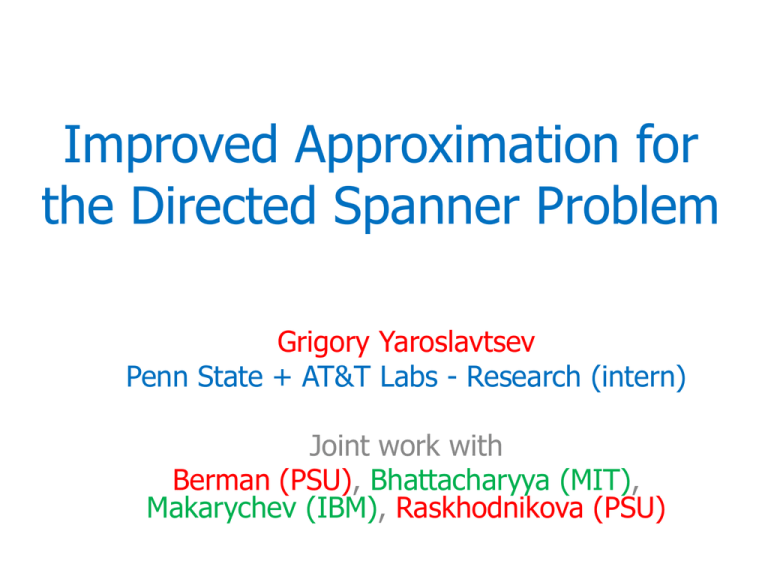
Improved Approximation for the Directed Spanner Problem Grigory Yaroslavtsev Penn State + AT&T Labs - Research (intern) Joint work with Berman (PSU), Bhattacharyya (MIT), Makarychev (IBM), Raskhodnikova (PSU) Directed Spanner Problem • k-Spanner [Awerbuch ‘85, Peleg, Shäffer ‘89] Subset of edges, preserving distances up to a factor k > 1 (stretch k). • Graph G V, E → k-spanner H(V, 𝑬𝑯 ⊆ 𝑬): ∀𝑢, 𝑣 ∈ 𝑉 𝑑𝑖𝑠𝑡𝑯 𝑢, 𝑣 ≤ 𝑘 ⋅ 𝑑𝑖𝑠𝑡𝐺 (𝑢, 𝑣) • Problem: Find the sparsest k-spanner of a directed graph (edges have lengths). Directed Spanners and Their Friends Applications of spanners • First application: simulating synchronized protocols in unsynchronized networks [Peleg, Ullman ’89] • Efficient routing [PU’89, Cowen ’01, Thorup, Zwick ’01, Roditty, Thorup, Zwick ’02 , Cowen, Wagner ’04] • Parallel/Distributed/Streaming approximation algorithms for shortest paths [Cohen ’98, Cohen ’00, Elkin’01, Feigenbaum, Kannan, McGregor, Suri, Zhang ’08] • Algorithms for approximate distance oracles [Thorup, Zwick ’01, Baswana, Sen ’06] Applications of directed spanners • Access control hierarchies • Previous work: [Atallah, Frikken, Blanton, CCCS ‘05; De Santis, Ferrara, Masucci, MFCS’07] • Solution: [Bhattacharyya, Grigorescu, Jung, Raskhodnikova, Woodruff, SODA’09] • Steiner spanners for access control: [Berman, Bhattacharyya, Grigorescu, Raskhodnikova, Woodruff, Y’ ICALP’11 (more on Friday)] • Property testing and property reconstruction [BGJRW’09; Raskhodnikova ’10 (survey)] Plan • • • • • Undirected vs Directed Previous work Framework = Sampling + LP Sampling LP + Randomized rounding – Directed Spanner – Unit-length 3-spanner – Directed Steiner Forest Undirected vs Directed • Every undirected graph has a (2t-1)-spanner with ≤ 𝑛1+1/𝑡 edges. [Althofer, Das, Dobkin, Joseph, Soares ‘93] – Simple greedy + girth argument 1 𝑡 – 𝑛 −approximation • Time/space-efficient constructions of undirected approximate distance oracles [Thorup, Zwick, STOC ‘01] Undirected vs Directed • For some directed graphs Ω 𝑛2 edges needed for a k-spanner: • No space-efficient directed distance oracles: some graphs require Ω 𝑛2 space. [TZ ‘01] Unit-Length Directed k-Spanner • O(n)-approximation: trivial (whole graph) Overview of the algorithm • Paths of stretch k for all edges => paths of stretch k for all pairs of vertices • Classify edges: thick and thin • Take union of spanners for them – Thick edges: Sampling – Thin edges: LP + randomized rounding • Choose thickness parameter to balance approximation Local Graph • Local graph for an edge (a,b): Induced by vertices on paths of stretch ≤ 𝑘 from a to b • Paths of stretch k only use edges in local graphs • Thick edges: ≥ 𝒏 vertices in their local graph. Otherwise thin. Sampling [BGJRW’09, FKN09, DK11] • Pick 𝒏 𝐥𝐧 𝒏 seed vertices at random • Add in- and out- shortest path trees for each • Handles all thick edges (≥ 𝑛 vertices in their local graph) w.h.p. • # of edges ≤ 2 𝑛 − 1 𝒏 𝐥𝐧 𝒏 ≤ 𝑂𝑃𝑇 ⋅ Õ 𝑛 . Key Idea: Antispanners • Antispanner – subset of edges, which destroys all paths from a to b of stretch at most k. • Spanner <=> hit all antispanners • Enough to hit all minimal antispanners for all thin edges • Minimal antispanners can be found efficiently Linear Program (dual to [DK’11]) Hitting-set LP: 𝑒∈𝐸 𝑥𝑒 → 𝑚𝑖𝑛 𝑥𝑒 ≥ 1 𝑒∈𝐀 for all minimal antispanners A for all thin edges. • # of minimal antispanners may be exponential in 𝑛 => Ellipsoid + Separation oracle 𝑛 1 2 𝑛 ln 𝑛 • Good news: ≤ 𝑛 = 𝑒 minimal antispanners for a fixed thin edge • Assume, that we guessed the size of the sparsest k-spanner OPT (at most 𝑛2 values) Oracle Hitting-set LP: 𝑒∈𝐸 𝑥𝑒 ≤ 𝑂𝑃𝑇 𝑥𝑒 ≥ 1 𝑒∈𝐀 for all minimal antispanners A for all thin edges. • We use a randomized oracle => in both cases oracle can fail with some probability. Randomized Oracle = Rounding • Rounding: Take e w.p. 𝑝𝑒 = min 𝒏 𝐥𝐧 𝒏 ⋅ 𝑥𝑒 , 1 • SMALL SPANNER: We have a spanner of size ≤ 𝑒 𝑥𝑒 ⋅ 𝑂 𝑛 ≤ 𝑂𝑃𝑇 ⋅ 𝑂 𝑛 w.h.p. • Pr[LARGE SPANNER or CONSTRAINT NOT VIOLATED] ≤ e− Ω( 𝑛) Unit-length 3-spanner • 𝑂(𝑛1/3 )-approximation algorithm • Sampling: 𝑂(𝑛1/3 ) times • Dual LP + Different randomized rounding (simplified version of [DK’11]) • For each vertex 𝑢 ∈ 𝑉: sample a real 𝑟𝑢 ∈ 0,1 • Take all edges 𝑢, 𝑣 : min 𝑟𝑢 , 𝑟𝑣 ≤ 𝑂(𝑛1/3 )𝑥(𝑢,𝑣) • Feasible solution => 3-spanner w.h.p. Conclusion • Sampling + LP with randomized rounding • Improvement for Directed Steiner Forest: – Cheapest set of edges, connecting pairs 𝑠𝑖 , 𝑡𝑖 – Previous: Sampling + similar LP [Feldman, Kortsarz, Nutov, SODA ‘09] – Deterministic rounding gives 𝑂 𝑛4/5+𝜖 approximation – We give 𝑂 𝑛2/3+𝜖 -approximation via randomized rounding Conclusion • • • • Õ( 𝒏)-approximation for Directed Spanner Small local graphs => better approximation Can we do better? Hardness: only excludes polylog(n)approximation • Integrality gap: 𝜴(𝒏𝟏/𝟑−𝝐 ) • Our algorithms are simple, can more powerful techniques do better? Thank you! • Slides: http://grigory.us
